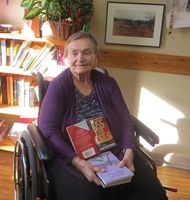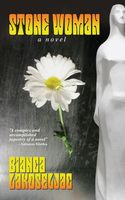Stone Woman: In conversation with Frances Gage, sculptor of "Woman"
By Bianca Lakoseljac
By Bianca Lakoseljac: OB Writer in Residence
My novel, Stone Woman, was inspired by two major Toronto artistic achievements: Frances Gage’s sculpture “Woman,” a white Carrera marble piece housed at Women’s College Hospital, and the 1967 Art Symposium in High Park, which was the first outdoor sculpture exhibit in Toronto. Back in spring, after my novel was completed and my publisher and I were working on final edits, I contacted Frances Gage and was happy that she agreed to a visit.
Although David Moratto, the book cover designer had obtained permission from Women’s College Hospital to use a photograph of Gage’s sculpture on my book cover, and similarly the videographer Gabriel Quigley had obtained permission to use a video of the sculpture in the book video, seeking Gage’s approval as well was a must for me. I needed to know that the artist who envisioned and created this whimsical and striking piece was all right with it.
A couple of weeks later, Ms. Gage and I spent a pleasant afternoon at Streamway Villa in Coburg where she lives. Ms. Gage talked about her work as a sculptor, about her life as an artist, and what inspired the various pieces she sculpted. We discovered many shared interests. We talked about our love of art, our lifelong enjoyment of gardening as a way of connecting with nature and appreciating the beauty around us, our concern and involvement with environmental issues, our affection for cats, our interest in travel, and our love of family.
Ms. Gage is one of the most prolific sculptors in Canada. She was born in 1924 and has been sculpting her whole life. In June 2016, she received the OMNI Health Care Lifetime Achievement Award. She continues to sculpt and cast small bronze pieces and works daily. The walls of her room are decorated with photos of Kenya and Tanzania where she traveled in 1955. Her work has been shown in several group exhibitions, most notably at the International Congress of Medallic Arts in Florence, Italy (1984), in Colorado City, Colorado (1987), Helsinki, Finland (1990), and London, England (1992).
Ms. Gage was happy to share her experiences as a woman-artist. I am glad to share my interview with the gracious and inspirational Frances Gage—a true Canadian icon.
1. Bianca Lakoseljac: I first saw “Woman” in the early 70s when I visited a friend at Women’s College Hospital. I was drawn to the sculpture the moment I saw it. To me, the figure seemed alive somehow, and I instantly thought of it as “she.” I was awed by the sculpture’s grace, by her scale—she is about two metres tall—and by the mystery of her veiled face. What inspired you to create such a whimsical piece?
Frances Gage: I was on a ship, traveling to Norway for another piece I was going to cast. That was in the mid-60s. “Woman” came to me in my thoughts. I saw her in my mind’s eye.
2. BL: “Woman” remained embedded in my subconscious for many years. When I began to write Stone Woman, the sculpture resurfaced in my thoughts. I also began to dream of her, and it came to me she was to be a mate to another sculpture that found a place in my novel, “The Hippy,” a black granite piece by William Koochin, created during the 1967 Art Symposium in High Park, and still standing at Sculpture Hill. Did you feel that there was a particular reason you wanted to sculpt “Woman?” Is there a meaning behind the piece?
Your CanLit News
Subscribe to Open Book’s newsletter to get local book events, literary content, writing tips, and more in your inbox
FG: When the image of the sculpture came to me, I also knew why I needed to sculpt her. “Woman” was to represent all women.
3. BL: How is the final result, the sculpture you created, different from the one you envisioned?
FG: The finished piece always becomes something else. It takes a life of its own.
4. BL: I feel that way about writing. My characters take a life of their own, and my novel is always very different from the story I first conceived of. Would you say that the process of sculpting is similar to writing?
FG: Yes. I would say so. I believe that is how a creative process works. You create something you envisioned in that you start with a vision and as you go through the process it evolves.
5. BL: Of all the sculptures you created, do you have a favourite piece?
FG: “Woman” is my all-time favourite.
6. BL: “Woman” was completed in 1971. I understand that it was commissioned by Women’s College Hospital sometime in the late 60s. How long did it take you to complete the piece?
FG: It took me two years of working on it, and about a year of planning it and doing the preliminary work. So about three years in total.
7. BL: A good part of my novel is set in the 60s. Did you spend much time in Yorkville in 1967?
FG: I lived at 1 Yorkville Avenue, opposite to a grocery store.
8. BL: What did you think of the bars and the coffee shops and the whole hippie scene?
FG: I was not part of it. I stayed completely out of the whole thing. I was busy with my work. That was the only thing that mattered to me.
9. BL: Is there something specific you would you like to share with your audience?
FG: What matters is your thought. Follow the inner voice. Whatever you do, wherever you are, it’s your thoughts that matter. Follow them, and they will guide you where you need to go.
10. BL: Would you like to share your philosophy on life?
FG: The only time is NOW. Not yesterday, not tomorrow. NOW exists. That’s all that matters.
11. BL: What is the most important thing in life?
FG: What matters is the final result. Your work of art.
12. BL: Other than your enjoyment of gardening, do you have other pastimes?
FG: I love travelling. I travelled as much as I could. As much as I could afford—money and time. I loved Africa, particularly Kenya. But it also made me sad. Colobus monkeys were hunted for their skins. They are so human-like. I could not bear to see them hunted. Now they are an endangered species. But there are always poachers out there. I felt so depressed about the whole situation, and I could do nothing about it. I found it hard to see how poor the people are. They have nothing. When it rains, they rush to puddles for water.
13. BL: You have been an inspiration to me. In my novel, your sculpture “Woman” also stands for all women—true to the inscription at the base of the sculpture.
The Dedication next to the sculpture housed at Women’s College Hospital states:
“Woman, made of 2000 lbs of Carrara marble, was created by the artist in 1971 to commemorate the dedicated women who built Women's College Hospital. As the shape of the Women's College institution evolves, she continues to embody the essence of past and future determination to champion Women’s Health.
Non quo sed quo modo - Not what we do but how.”
14. BL: I am so pleased and honoured to have this talk. I look forward to “Woman” being reinstalled at a public space again for all to admire.
FG: So am I. I am very glad you saw “Woman” as an inspiration.
Back in June, at Canadian Writers’ Summit in Toronto, in conversation with Susan Crean, author of The Laughing One: A Journey to Emily Carr, I talked about my visit with Frances Gage. In a subsequent email, Susan shared her memory of Ms. Gage, when she was a young girl at a summer camp in Algonquin Park and Ms. Gage was a leader: “I am so happy to hear Franny is still alive. I knew her intermittently between 1954 and 1961 or so. I doubt she would remember me (it was at a summer camp for girls in Algonquin Park) but I could never forget her, her work, or her wonderful deep sonorous singing voice. She'd go out in a canoe on a still night and sing to us, her voice carrying across the water.”
The book video for Stone Woman features Gage's "Woman" as well as a number of sculptures created during the 1967 Art Symposium in High Park: William Koochin's "The Hippy," Hubert Dalwood's "The Temple," Wessel Couzijn's "Midsummer Night's Dream," and Mark di Suvero's "Flower Power" and "No Shoes."
Book Video link for Stone Woman: /www.youtube.com/watch?v=AguJMgdky-U
Photo: Frances Gage, April 2016.
Photo: Frances Gage's sculpture, "Woman," housed at Women's College Hospital in Toronto.
Photo: Book cover for novel, Stone Woman—set in Toronto's High Park and Yorkville, published by Guernica Editions, fall 2106.
Stone Woman is a saga of five women whose lives are bound by a Vietnam War draft dodger David from the hippie daze of Toronto. It begins in 1967 during the Art Symposium in High Park. The story draws the reader into a web of liaisons—into David's love affair with Liza, his covert dealings with Liza's friend Anna, and the mysterious Helena. The intrigue culminates in the convergence of their loves and tragedies, and quests for social and cultural change inherent in the tumultuous milieu of the period. The story is brought to the present through the lives of the women's daughters, Blossom and Jane, who discover that their family secrets have been sculpted—literally—into an art form that imparts a sense of homecoming and alludes to a more hopeful future. The novel concludes with a fictional celebration of Canada's sesquicentennial in 2017. Available at indigo: https://www.chapters.indigo.ca/en-ca/books/stone-woman/9781550719871-item.html; the Amazon: https://www.amazon.ca/Stone-Woman-Bianca-Lakoseljac/dp/1550719874 ; at Guernica Editions:https://www.guernicaeditions.com/ and various book stores: Another Story bookstore; Book City. For more info on Bianca Lakoseljac's books, please see: www.biancalakoselac.ca.
.............................................................................................................................................................................................................
The views expressed in the Writer-in-Residence blogs are those held by the authors and do not necessarily reflect the views of Open Book.
Bianca Lakoseljac second novel, Stone Woman, which relives Toronto’s 1967 “summer of love”, has just been released by Guernica Editions. Bianca is the author of a novel, Summer of the Dancing Bear; a collection of stories, Bridge in the Rain (Guernica, 2012, 2010); and a book of poetry, Memoirs of a Praying Mantis (Turtle Moons Press, 2009). She is TWUC liaison for the National Reading Campaign, past president of the Canadian Authors Association, Toronto, has judged various national literary competitions, and has served on a number of literary contest panels. Bianca taught at Ryerson University and Humber College.
You can write to Bianca throughout the month of November at writer@open-book.ca.






